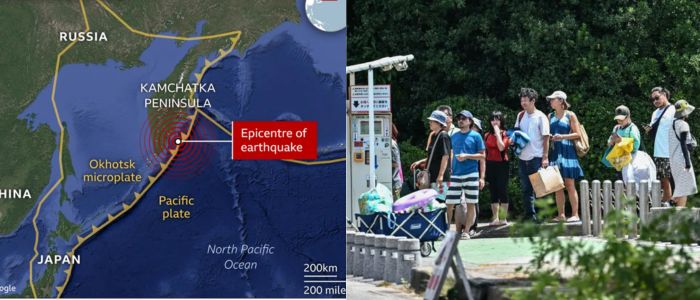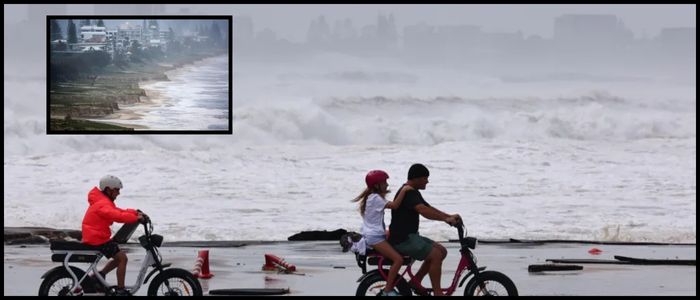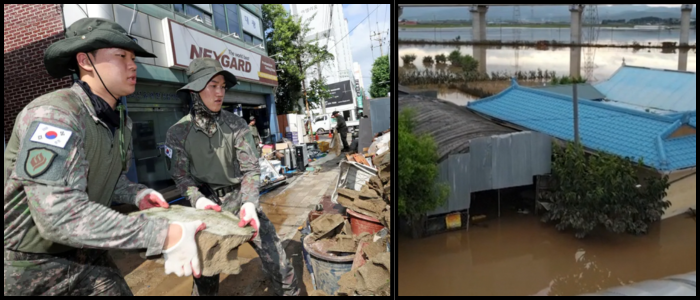The initial fears mirrored the damage wrought by the Indian Ocean tsunami in 2004 or Japan in 2011 but, in this case, the actual tsunami damage has been far less than anticipated.
Tsunami waves as high as 4 meters (13 feet) hit some areas in eastern Russia, but in general the impact was moderate. Now experts around the world are scrutinizing why a quake so large did not create a far more devastating tsunami.
What Caused the Massive Quake?
The earthquake struck off the Kamchatka Peninsula, a seismically active region in the "Pacific Ring of Fire." That area is where constantly moving and colliding tectonic plates meet.
Here the Pacific Plate, travelling northwestwards at 8cm per year, is being pushed under the smaller Okhotsk microplate. This process, known as subduction, frequently results in megathrust earthquakes as the plates lock together and suddenly release accumulated energy.
Megathrust quakes, like this one, occur over a wide area and involve the vast movement of the earth's crust. Seismologists say the duration of such an event can run many hundreds of kilometers under the sea floor and generate megamagintudes.
The area suffered a 9.0-magnitude earthquake in 1952, and prior to the quake in 2011 there was statistical evidence of a major quake having hit the same spot. The relatively shallow depth of Wednesday's quake — around 20.7km (12.9 miles) beneath the surface — also helped trigger the ocean's floor displacement, which is critical to a tsunami forming.
Why the Tsunami Wasn't as Devastating
Despite the size of the quake, the resulting tsunami was much less destructive than previous disasters, such as those in 2004 and 2011. There are a few reasons.
For one thing, the shape of the ocean floor and the coastal land has a big impact on the way tsunami waves interact. In this instance the underwater topography and coastal geography could have dissipated wave energy before it hit the coastline.
Secondly, while waves from a tsunami can race across the ocean at more than 500mph (800km/h), the speed comes at the cost of height and they only begin to speed up and rise when they approach shallow water. The highest wave recorded – of 4m – dwarfed the tens-of-metres-high waves reported in other calamities.
Some seismologists also suspect that the actual depth of the quake may actually have been a bit deeper. A deeper quake would generate less vertical movement of the seafloor and smaller tsunami waves.
Early warning systems finally are now crucial in reducing catastrophe. Since 2004, a number of countries around the Pacific have spent heavily on sophisticated tsunami probably monitoring and warning systems.
These systems can alert the public in time to get out, saving lives as well as property. In this case, millions were evacuated to safety in time.
It happened ten days before a significant quake of 7.4 magnitude shook the same area. This could have been a foreshock, a smaller burst of energy preceding the larger one, scientists said. Yet though foreshocks can serve as indicators of impending earthquakes, they are not precise harbingers of when.
Monitoring Continues as Aftershocks Expected
The worst, it seems, is over, but aftershocks are likely. The Russian Academy of Sciences Geophysical Survey (GS RAS) is following the area closely and predicts that aftershocks will continue for at least another month.
Although the quake was among the most powerful ever recorded, a combination of geological factors and improved warning systems minimized the potential disaster.
But scientists emphasize the continued need to invest in seismic monitoring and public preparedness to reduce the risk in tectonically active regions such as the Pacific Ring of Fire.
Environment

Why Russian Mega Quake Caused Limited Tsunami Damage

A magnitude 8.8 earthquake hit eastern Russia at 11:25 local time (00:25 BST) makes it one of the strongest ever recorded. The quake prompted tsunami warnings across the Pacific, and evacuations along Pacific coastal regions.















